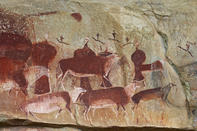Home to the San
Fort Beaufort was originally home to one of Southern Africa’s indigenous groups collectively known as the San people. The San people are also called Bushmen by members outside of their cultural group. It should be known that the San people had names for themselves, such as |Xam-ka-!e and the ||Xegwi to name a few.

These nomadic hunter-gatherers settled in the beautiful Blinkwater River Valley. Later on, other ethnic groups from Africa migrated into Southern Africa. Which resulted in the Fort Beaufort region becoming home to the San and many other sub-Xhosa tribes who thrived in the valley for centuries.
Duke of Beaufort
Fort Beaufort developed around a military post established in 1822 in a bend of the Kat River by Colonel Maurice Scott, to counter raids by the Xhosa chief, Maqoma. It was named after the Duke of Beaufort, the father of Lord Charles Somerset. Many wars and conflicts ensued between the British, the Xhosa, and San people.
These wars, which would last almost 100 years, became known as the Frontier Wars. At the end of the Sixth Xhosa War (1834-35) the British Governor, Sir Benjamin D'Urban, ordered the construction of strong fortifications in the border region. The circular Martello Tower, built in 1837 of dressed stone, provided a formidable defence against any attack, and at times also served as a safe haven.
In 1840, Fort Beaufort officially became a town. After the 8th Frontier War and an unsuccessful attack by the Xhosa and San people against the British, Fort Beaufort came under British occupation until 1870.
The fight for Fort Beaufort was a long and incredible one that has shown resilience from its inhabitants in the town and the province. The Eastern Cape also has more forts than any other region in the whole of Africa.